Physical Address
304 North Cardinal St.
Dorchester Center, MA 02124
The posteromedial corner of the knee (PMC) is a significant anatomic structure that is as important as the posterolateral corner in multiligamentous injuries. Even though it is easily seen on modern high-field magnetic resonance (MR) imaging systems, it is often unnoticed and there is a lack of knowledge of its complex anatomy and function. Appropriate understanding of its structures, including knowledge about its normal appearance on MR imaging and specific biomechanical function can help in easy recognition of PMC injuries.
The posteromedial corner of the knee is between the posterior margin of the longitudinal fibers of the superficial medial collateral ligament (MCL) and the medial border of the posterior cruciate ligament (PCL). Some variations exist due to certain investigators including the posterior oblique ligament (POL) as a part of the MCL, and others referring to the posteromedial joint capsule as all structures posterior to the superficial MCL. Even though there is some controversy regarding the structures in this area, five major components have been consistently described in the literature.
The PMC plays a significant role in stabilizing the medial corner of the knee and preventing excessive anterior translation and external rotation of the medial tibial plateau with respect to the femur. Injuries to the PMC and therefore disruptions of its supporting structures can cause anteromedial rotational instability (AMRI).
Posteromedial corner injuries also usually occur simultaneously with injuries to other important knee-stabilizing structures such as the anterior cruciate ligament (ACL) and the PCL. Overlooked PMC injuries may be a cause of failure of surgical management, such as ACL and PCL graft failures and increased stress and tension on reconstructed knee ligaments. Having good knowledge and understanding of the anatomic structures of the PMC and their static and dynamic roles in supporting the knee can help detect various forms of injuries. Consequently, the ability to recognize PMC injuries is highly invaluable in determining proper diagnosis, which may alter or even require further surgical management. This chapter reviews the anatomy of the PMC, its function in supporting the medial knee, and common PMC injuries including the associated clinical symptoms and available treatment options.
The medial-side supporting structures of the knee can be divided into three layers: Layer I, crural fascia including the pes anserine tendons; Layer II, superficial MCL and the oblique popliteal ligament (OPL); and Layer III, the joint capsule, semimembranosus, and the deep medial collateral ligament ( Figs. 11.1 and 11.2 ). Structures between the posterior margin of the superficial MCL and the medial margin of the PCL combine to form the PMC.
![FIG 11.1, (A) Anatomic illustration of the most superficial medial structure of the knee. This illustration highlights layer I, which is the deep crural fascia. Arrow points to the sartorius muscle. (B) Anatomic illustration of the medial corner structures depicting layer II, which includes the superficial MCL (long arrow) . Arrowhead depicts the semimembranosus tendon. Short arrow depicts the sartorius muscle, which is cut and retracted. (C) Sagittal anatomic illustration of layer III, which includes the joint capsule, semimembranosus, and the deep medial collateral ligament ( MCL, long arrow) . Superficial MCL (arrowheads) is cut and retracted in this illustration. Short arrow depicts the semimembranosus tendon. (D) Axial anatomic illustration of the layers of the PMC of the knee. Layer I is the crural fascia (thin arrow) and also includes the pes anserinus [(A) sartorius tendon, (B) gracilis tendon, and (C) semitendinosus tendon]. Layer II (long arrow) is the superficial MCL. Layer III (white arrowhead) includes the joint capsule, semimembranosus, and the deep MCL. Also illustrated is the POL (white arrow) . FIG 11.1, (A) Anatomic illustration of the most superficial medial structure of the knee. This illustration highlights layer I, which is the deep crural fascia. Arrow points to the sartorius muscle. (B) Anatomic illustration of the medial corner structures depicting layer II, which includes the superficial MCL (long arrow) . Arrowhead depicts the semimembranosus tendon. Short arrow depicts the sartorius muscle, which is cut and retracted. (C) Sagittal anatomic illustration of layer III, which includes the joint capsule, semimembranosus, and the deep medial collateral ligament ( MCL, long arrow) . Superficial MCL (arrowheads) is cut and retracted in this illustration. Short arrow depicts the semimembranosus tendon. (D) Axial anatomic illustration of the layers of the PMC of the knee. Layer I is the crural fascia (thin arrow) and also includes the pes anserinus [(A) sartorius tendon, (B) gracilis tendon, and (C) semitendinosus tendon]. Layer II (long arrow) is the superficial MCL. Layer III (white arrowhead) includes the joint capsule, semimembranosus, and the deep MCL. Also illustrated is the POL (white arrow) .](https://storage.googleapis.com/dl.dentistrykey.com/clinical/MedialSupportingStructuresMedialCollateralLigamentandPosteromedialCorner/0_3s20B9780323400466000113.jpg)
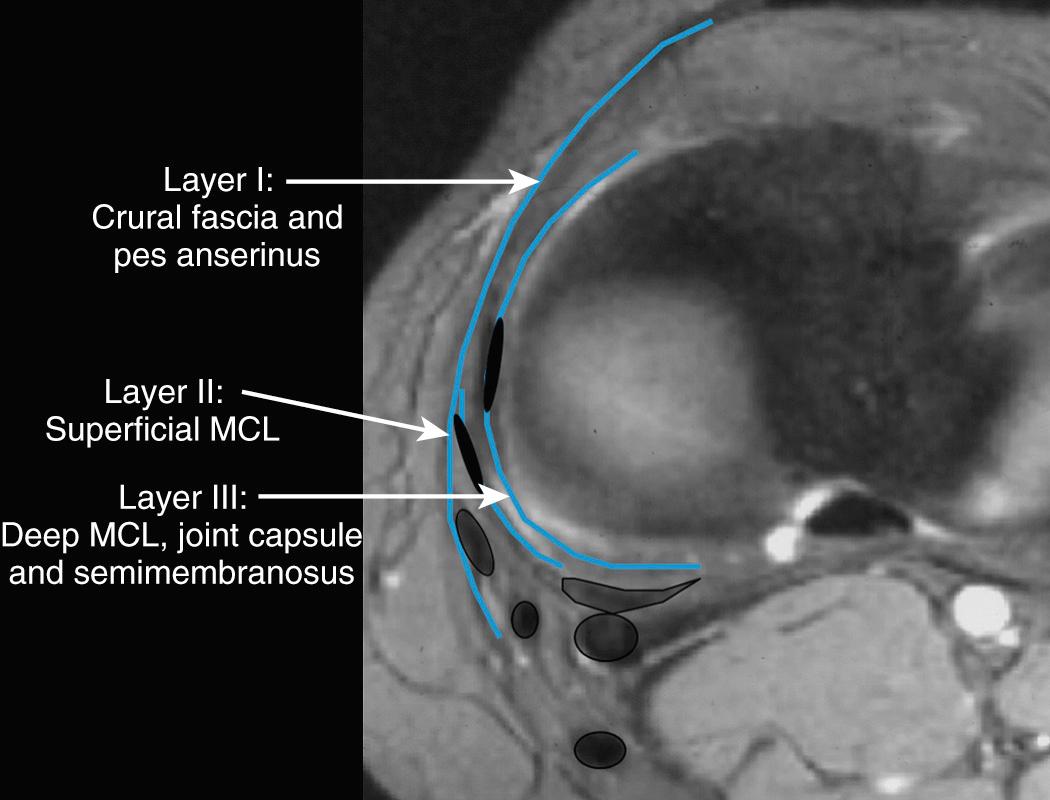
The PMC is a complex anatomic region containing several structures important for the stability and proper biomechanical functioning of the knee. It is difficult to delineate the separate structures of the PMC owing in large part to anatomic variability and relatively thin capsular components. There are five main components of the PMC: the semimembranosus tendon complex, the OPL, the POL, the posteromedial joint capsule, and the posterior horn of the medial meniscus ( Figs. 11.3 to 11.9 ).
![FIG 11.3, (A) Semimembranosus tendon complex: Anatomic illustration demonstrating the various arms/divisions of the complex and their relationships to each other, the oblique popliteal ligament (OPL), the arcuate ligament, and the biceps femoris tendon (BFT). This illustration highlights the semimembranosus tendon (SMT) located in the posterior medial aspect of the knee and its five divisions: [1] anterior arm (Ant) , [2] direct arm (Dir) , [3] inferior arm (Inf) , [4] OPL, and [5] capsular arm. The capsular arm is located deeper and not depicted in this image. Note the relationship between the OPL and the arcuate ligament (Arc) . The biceps femoris tendon (BFT) is seen in the posterolateral aspect of the knee. BFT, Biceps femoris tendon; OPL, oblique popliteal ligament; SMT, semimembranosus tendon. FIG 11.3, (A) Semimembranosus tendon complex: Anatomic illustration demonstrating the various arms/divisions of the complex and their relationships to each other, the oblique popliteal ligament (OPL), the arcuate ligament, and the biceps femoris tendon (BFT). This illustration highlights the semimembranosus tendon (SMT) located in the posterior medial aspect of the knee and its five divisions: [1] anterior arm (Ant) , [2] direct arm (Dir) , [3] inferior arm (Inf) , [4] OPL, and [5] capsular arm. The capsular arm is located deeper and not depicted in this image. Note the relationship between the OPL and the arcuate ligament (Arc) . The biceps femoris tendon (BFT) is seen in the posterolateral aspect of the knee. BFT, Biceps femoris tendon; OPL, oblique popliteal ligament; SMT, semimembranosus tendon.](https://storage.googleapis.com/dl.dentistrykey.com/clinical/MedialSupportingStructuresMedialCollateralLigamentandPosteromedialCorner/2_3s20B9780323400466000113.jpg)
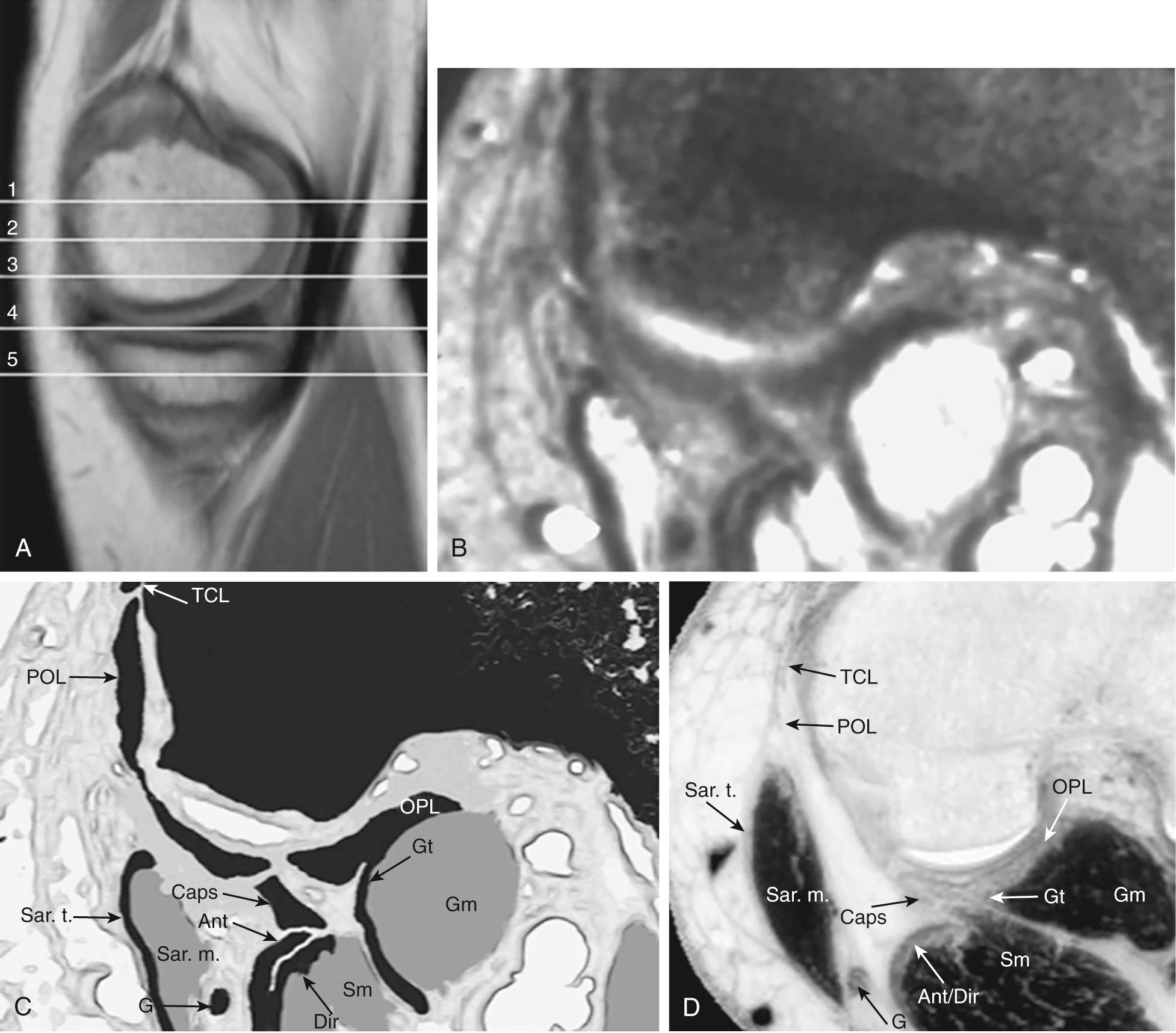
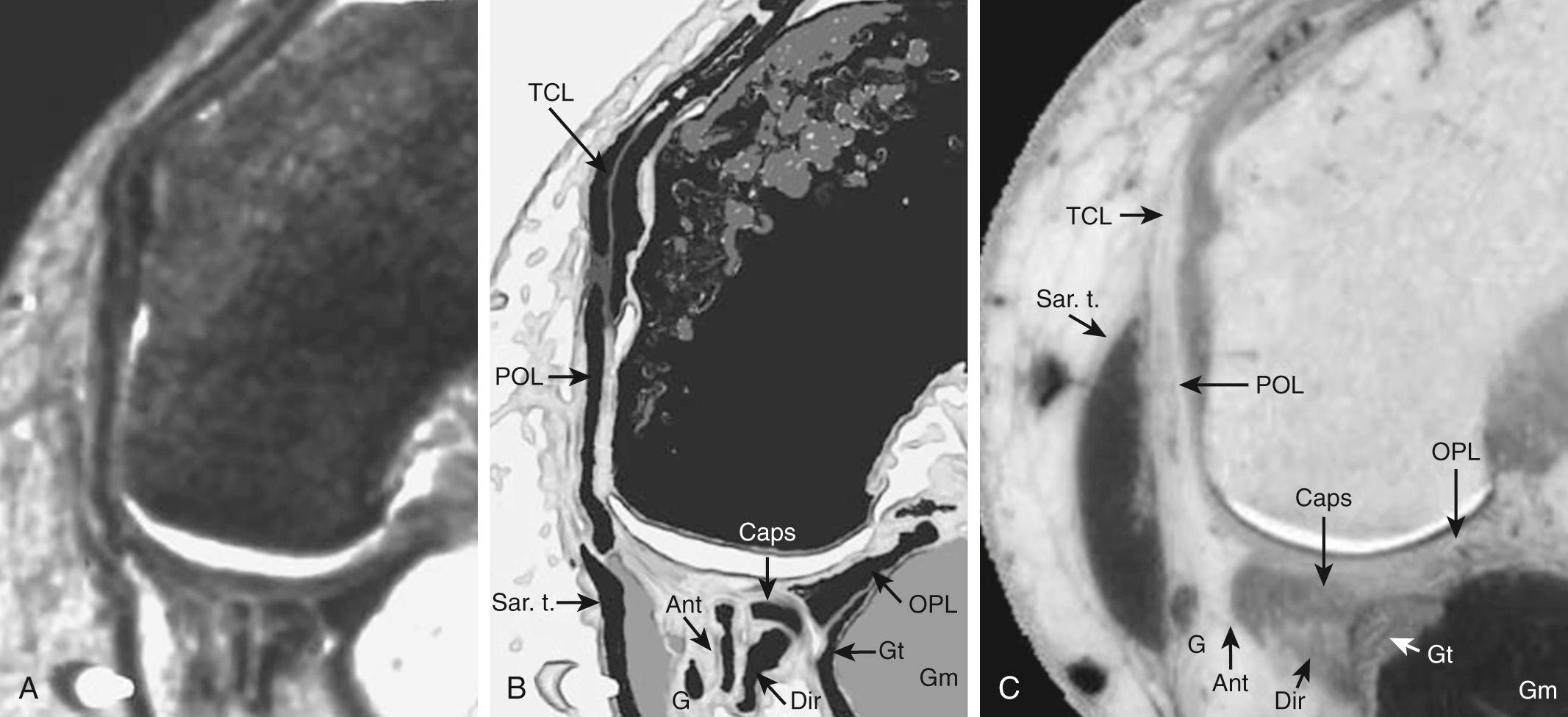
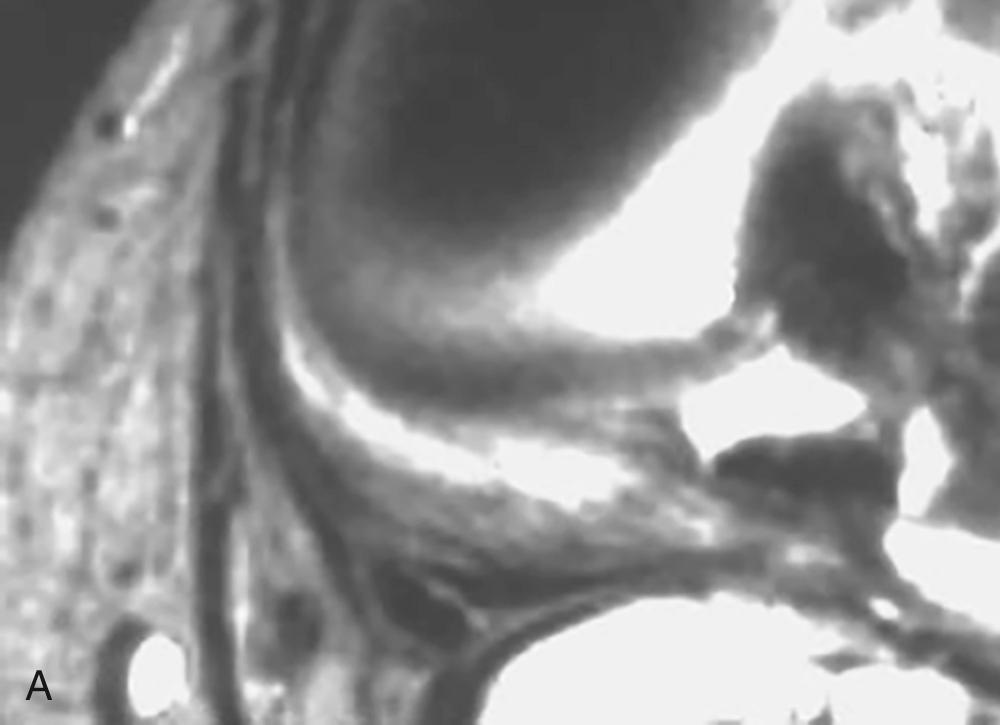
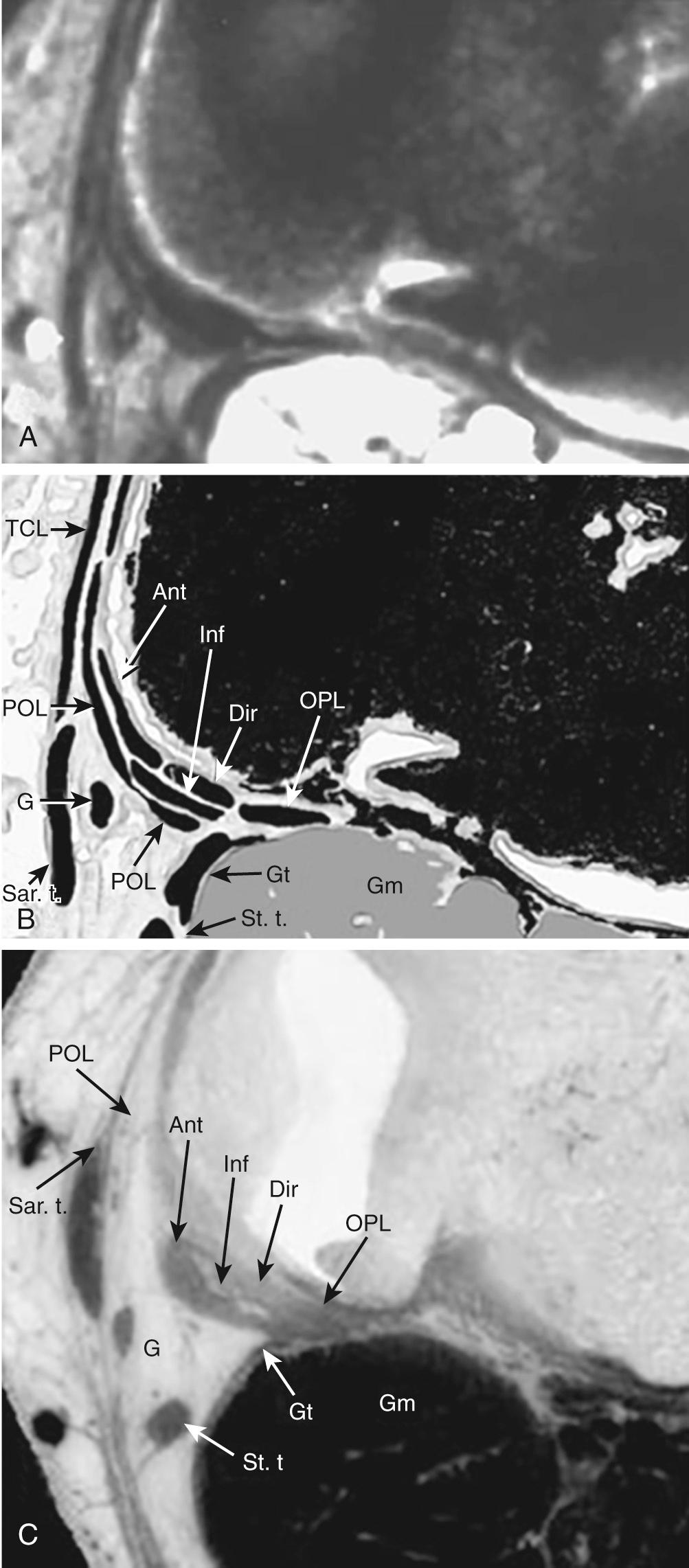
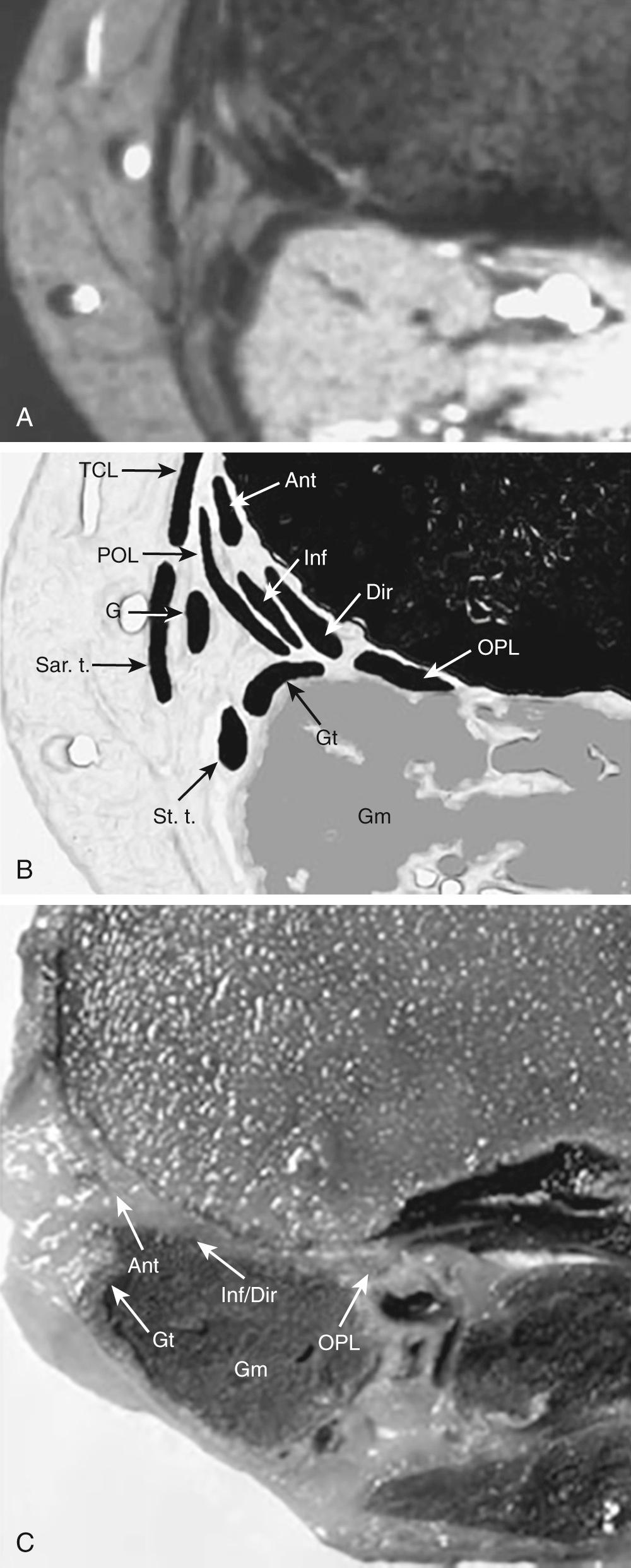
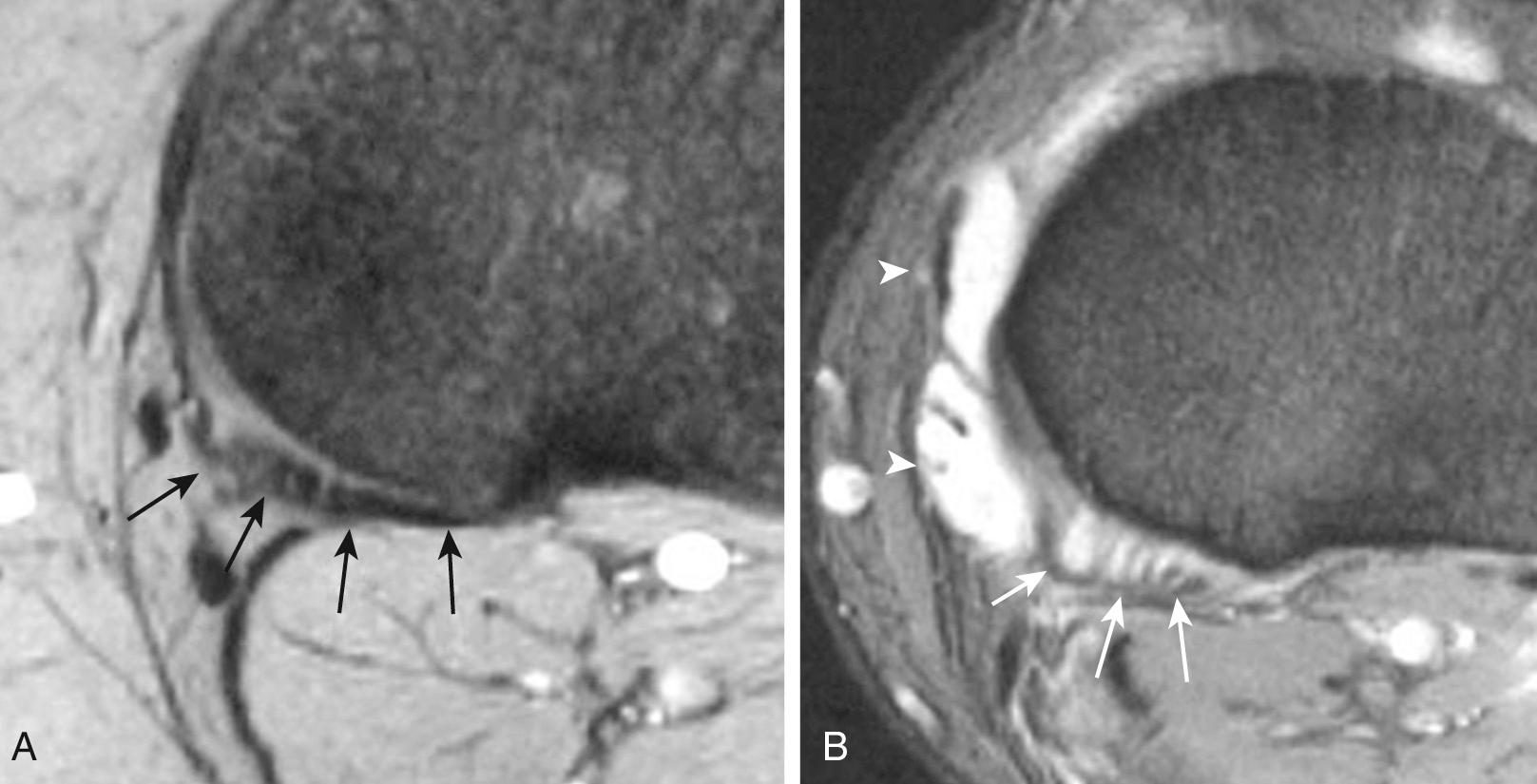
The semimembranosus tendon is the most important dynamic stabilizer of the PMC. It originates at the posterolateral aspect of the ischial tuberosity. Distally, it divides into five anatomically distinct tendinous branches, each inserting into the posteromedial region of the knee: (1) the direct arm (principal attachment), (2) the capsular arm, (3) the extension to the OPL (OPL insertion), (4) the anterior arm (tibial or reflected arm, pars reflexa), and the (5) inferior (popliteal) arm (see Figs. 11.3 to 11.9 ). The insertion sites include the infraglenoid tubercle of the posteromedial tibial plateau, the posterior capsule, the posterior horn of the medial meniscus, and a portion of the capsule deep to the MCL. Axial MR images may often demonstrate a small amount of fat accumulation between the different arms of the semimembranosus tendons at the level of the joint line, which is considered a normal variant. Axial sections obtained at the level of the upper portion of the femoral condyles may demonstrate the semimembranosus tendon before it branches into the five different arms as a “ C ”-shaped structure or as a “ 3 ”-shaped structure adjacent to the distal semimembranosus muscle.
The direct arm has an anterior course deep to the anterior arm and inserts at the tubercle on the posteromedial tibial condyle, also known as the tuberculum tendinis . Immediately prior to its tibial insertion, it attaches to the posterior aspect of the coronary ligament of the posterior horn of the medial meniscus. The insertion site of the direct arm is best visualized on both sagittal and axial images. The anterior and direct arms together may form a low-signal-intensity band along the posteromedial aspect of the tibia, distal to the articular margin and inseparable from each other (see Figs. 11.3 to 11.9 ).
The capsular arm of the semimembranosus tendon is best visualized on axial images. This arm is seen as a deep-lying, flat, striated structure arising from the posterior medial aspect of the tibial plateau, which then combines with the posteromedial capsule to join the capsular portions of both the OPL and POL. This arm is better appreciated as a separate structure when the joint is distended by fluid, although this is not very common. Hence, the capsular arm is seen as a flat striated structure located in the posterior medial aspect of the tibial plateau, inseparable from the adjacent direct and anterior arms arm while continuous to the OPL (see Figs. 11.3 to 11.9 ).
The anterior or tibial arm, also known as the reflected arm , extends anteriorly, passing under the POL, and inserts on the medial aspect of the proximal tibia under the tibial collateral ligament. Most commonly, this arm is seen on medial peripheral sagittal images as a low-signal-intensity structure curving anteriorly and taking an almost horizontal course. When the knee is fully extended, there is angulation of the anterior arm, resulting in a focal area of high signal intensity within the tendon with a echo time (TE) of 20 ms consistent with a magic angle artifact ( Fig. 11.10 ). On sequential coronal images, the horizontal portion of the anterior arm is seen as a round or oval hypointense or as a thin structure adjacent to the medial aspect of the tibia, under the tibial collateral ligament and POL ( Fig. 11.11 ). The thickness of the anterior arm varies significantly between normal individuals. On sequential axial images, the anterior arm is demonstrated as a hypointense structure adjacent to the posterior medial aspect of the tibia, extending anteriorly in consecutive sections (see Figs. 11.4 to 11.9 ).
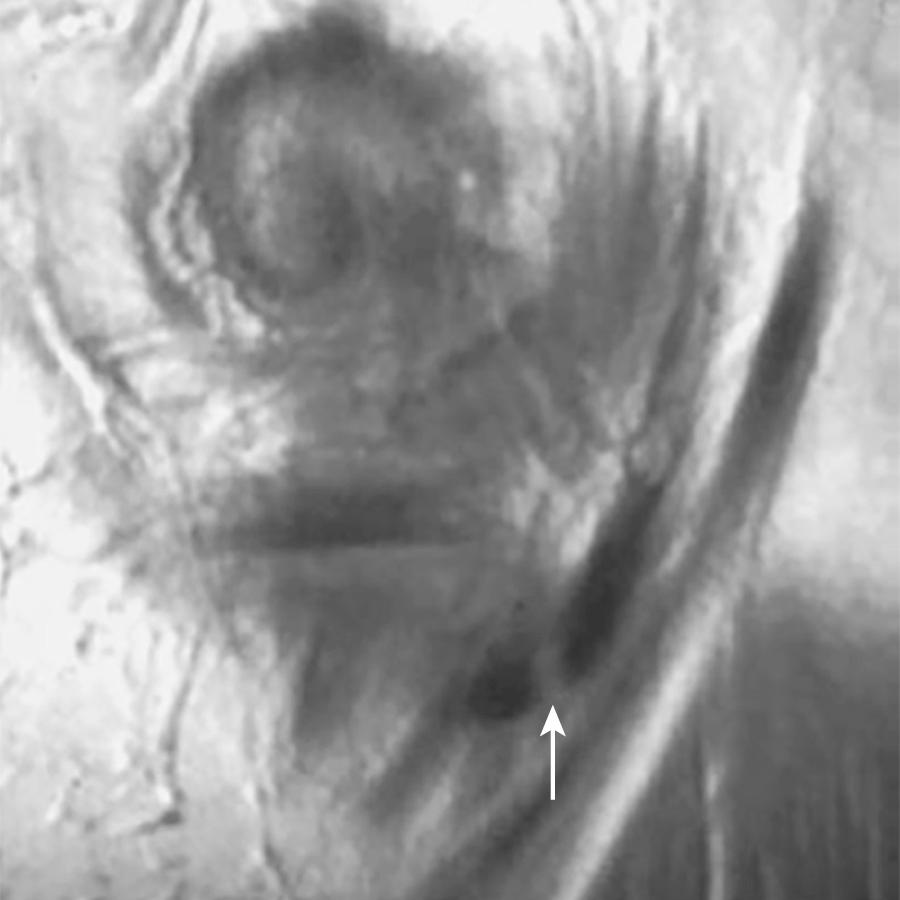
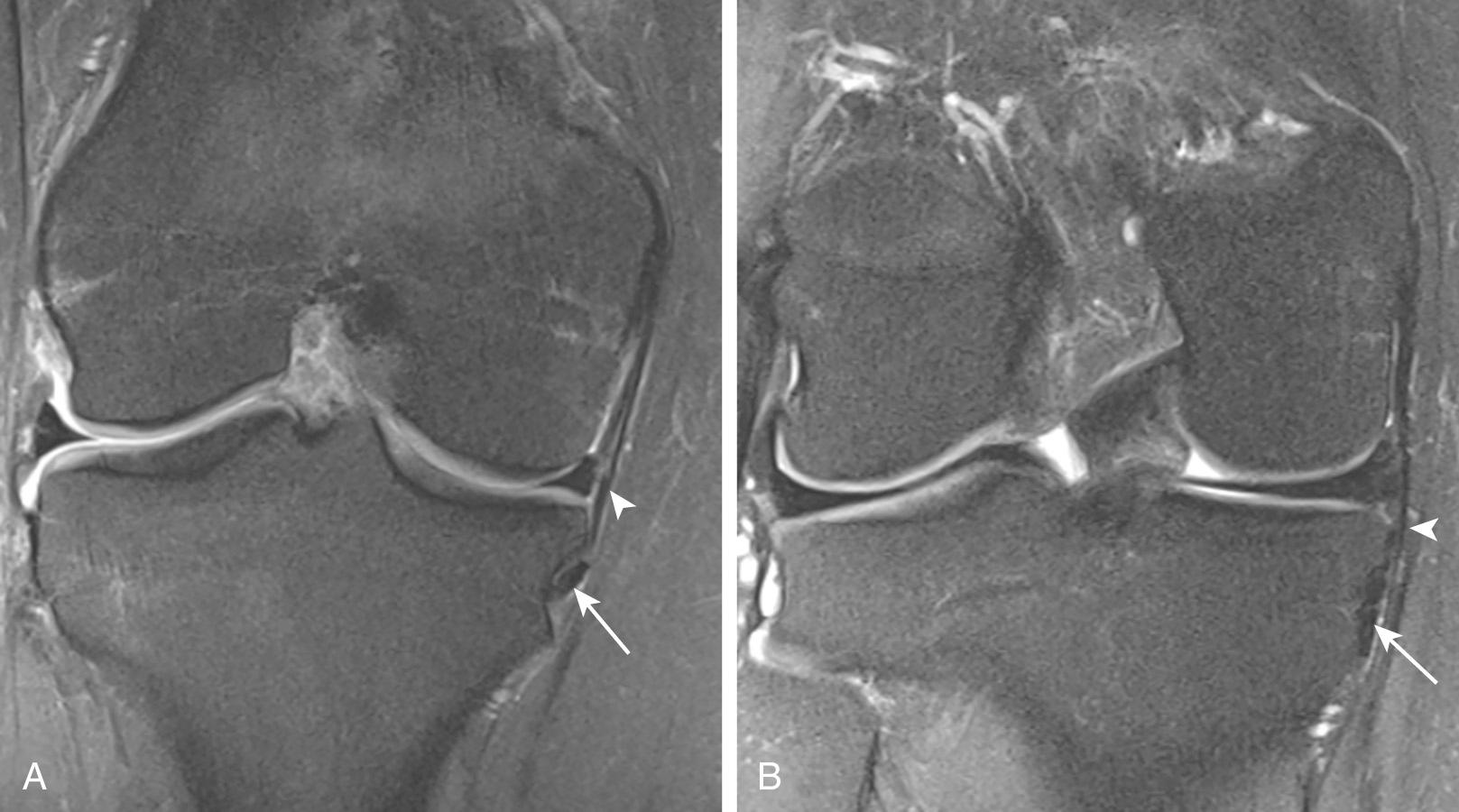
The inferior or popliteal arm extends more distally than the anterior and the direct arms. It passes under the distal tibial segments of the POL and the tibial collateral ligament, inserting just above the tibial attachment of the tibial collateral ligament. On sequential axial MR images, the inferior arm is seen as a low-signal-intensity structure extending inferiorly and anteriorly from the posterior margin of the joint line, deep to the MCL. The anterior arm is sometimes further divided into medial and lateral divisions, with the attachment to the medial tibia forming the medial division and the lateral division extending over the popliteal fascia (see Figs. 11.3 to 11.9 ). *
* References .
The POL or ligament of Winslow originates in the adductor tubercle of the femur. Its anterior margin combines with the posterior margin of the superficial MCL and its posterior margin joins the joint capsule, which is part of layer III. The POL has three bundles of attachment that are inseparable: (1) the superficial arm, or fascial tissue of the pes anserinus, (2) the tibial arm, or the posterior medial aspect of the tibia and the posterior horn of the medial meniscus, and (3) the capsular arm, which merges with the capsular arm of the semimembranosus tendon (SMT) and OPL (see Fig. 11.3 ). The tibial arm is considered the thickest and most important of these arms. This arm extends posteriorly and obliquely and inserts into the posteromedial aspect of the medial meniscus and the adjacent posteromedial aspect of the tibia, migrates deep to the anterior arm of the semimembranosus tendon, and finally merges with the main part of the tendon (see Fig. 11.3 ). The tibial arm is seen best on the sequential coronal and axial images, running immediately posterior to the superficial MCL as it joins with the capsule while inserting into the medial meniscus and the adjacent tibia. The capsular arm of the POL lies superior to the joint line of the knee. This arm is continuous with the posterior joint capsule and combines with the capsular arm of the semimembranosus tendon to form the proximal aspect of the OPL (see Fig. 11.3 ). Using the axial images, the capsular arm is commonly seen at the level of the femoral condyle, while on coronal images it presents as a thin hypointense band that extends posteriorly from the superficial MCL to combine with the medial aspect of the posterior capsular structures. Finally, the superficial arm inserts into the sheath and tibial insertion points of the semimembranosus tendon, combines with the posterior margin of the superficial MCL, and passes superficially to the anterior arm of the semimembranosus tendon (see Fig. 11.3 ). The superficial arm is best visualized on coronal images as a thin hypointense band superficial to the direct insertion of the semimembranosus tendon and extends from its origin to insert into the medial aspect of the tibial plateau.
The OPL is a thin, broad, lateral extension of the semimembranosus tendon. It both covers and blends with the posterior medial capsule to extend beyond the midline of the joint and unites with the arcuate ligament from the posterolateral aspect of the knee. The OPL originates from both the capsular arm of the POL and the lateral expansion of the semimembranosus. It transcends laterally to insert into the osseous or cartilaginous fabella, the meniscofemoral portion of the posterolateral joint capsule, and the plantaris muscle (see Fig. 11.3 ). The fibrous attachment of the OPL attaches to the lateral aspect of the PCL facet. Coronal and sagittal images may demonstrate this thin structure as a low-signal-intensity line indistinguishable in most cases from the posterior capsule but in continuity with the main tendon of the semimembranosus ( Figs. 11.12 and 11.13 ).
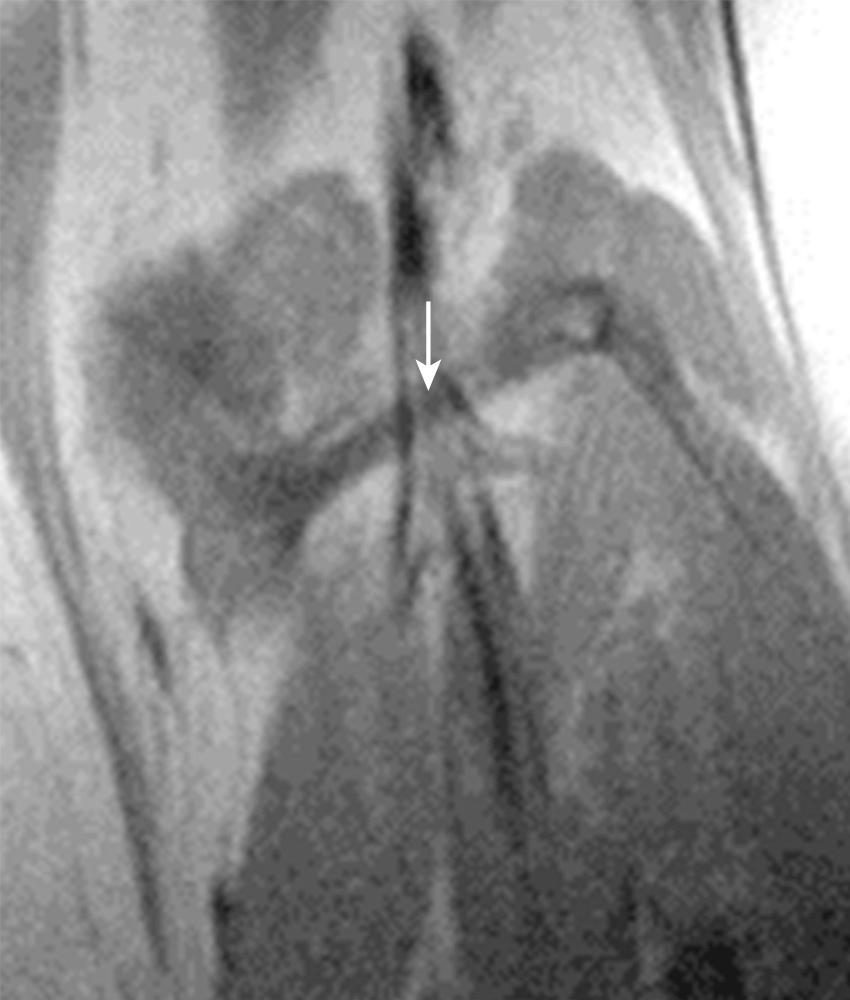
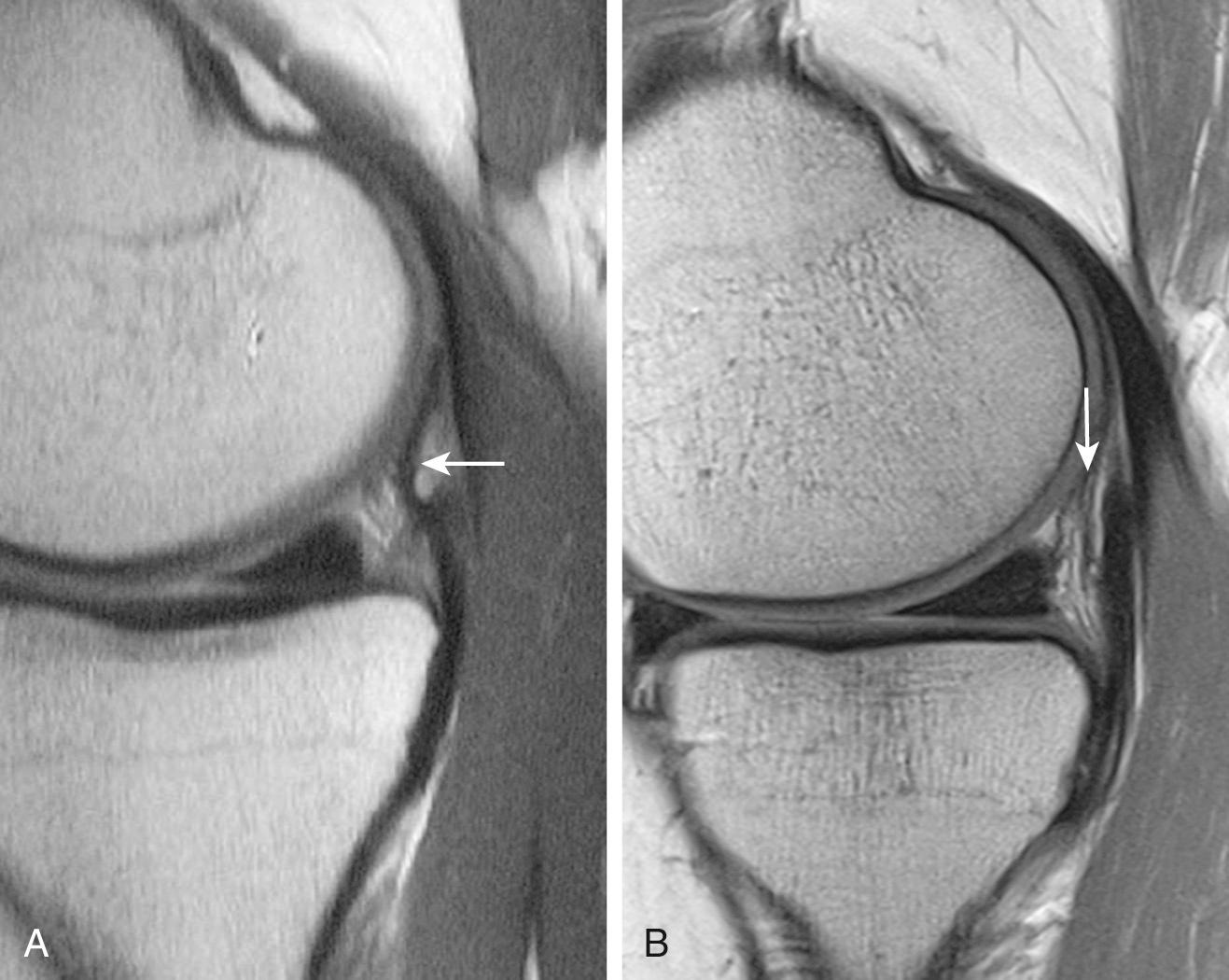
Become a Clinical Tree membership for Full access and enjoy Unlimited articles
If you are a member. Log in here